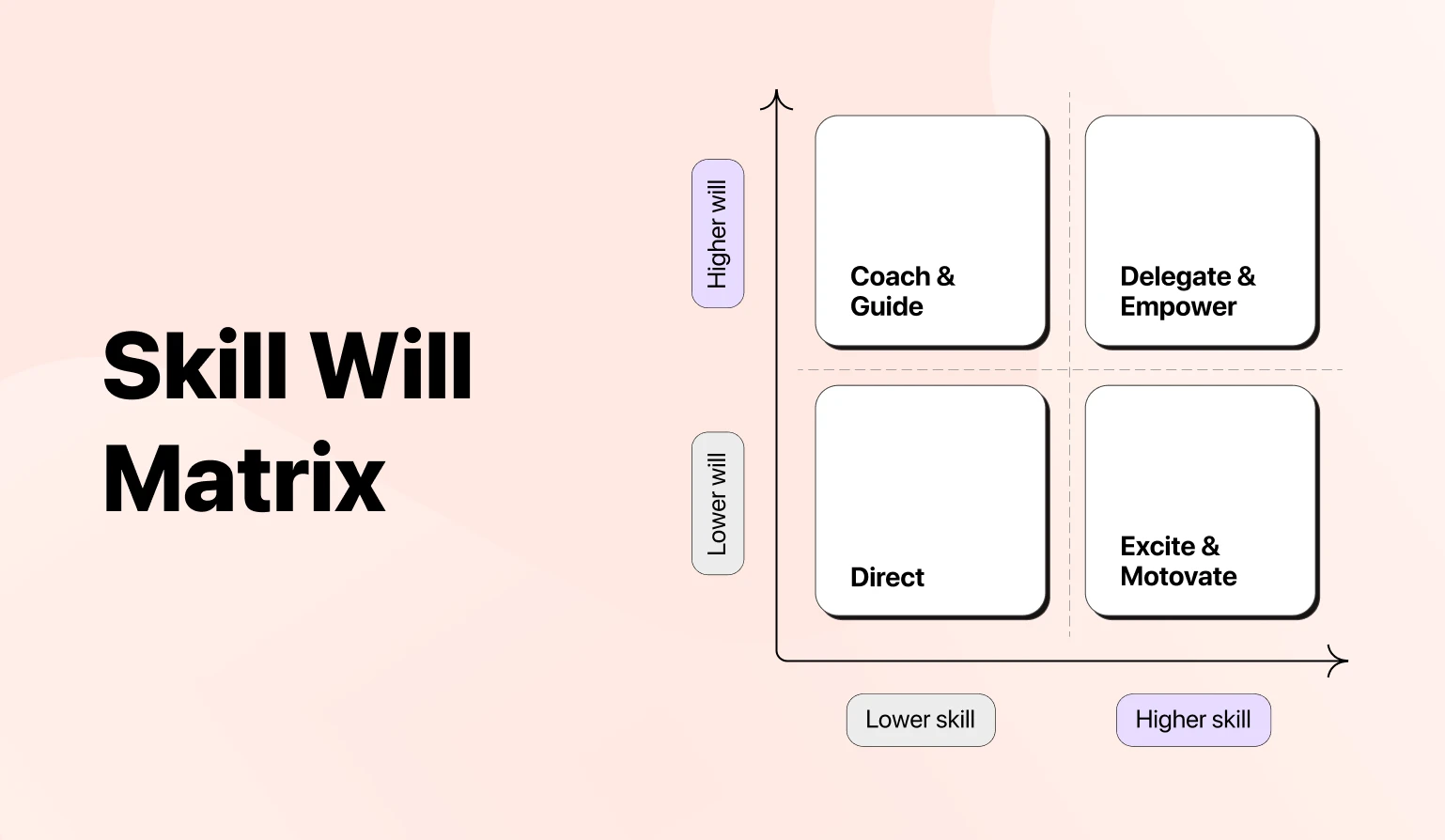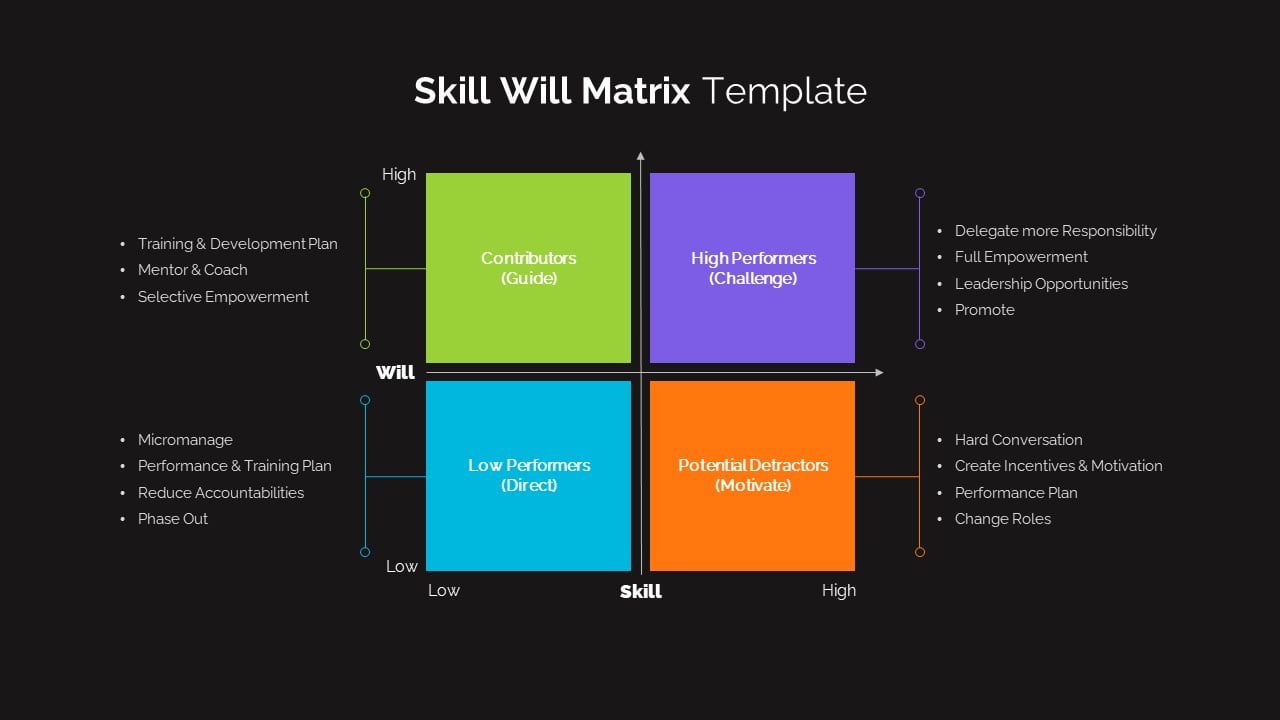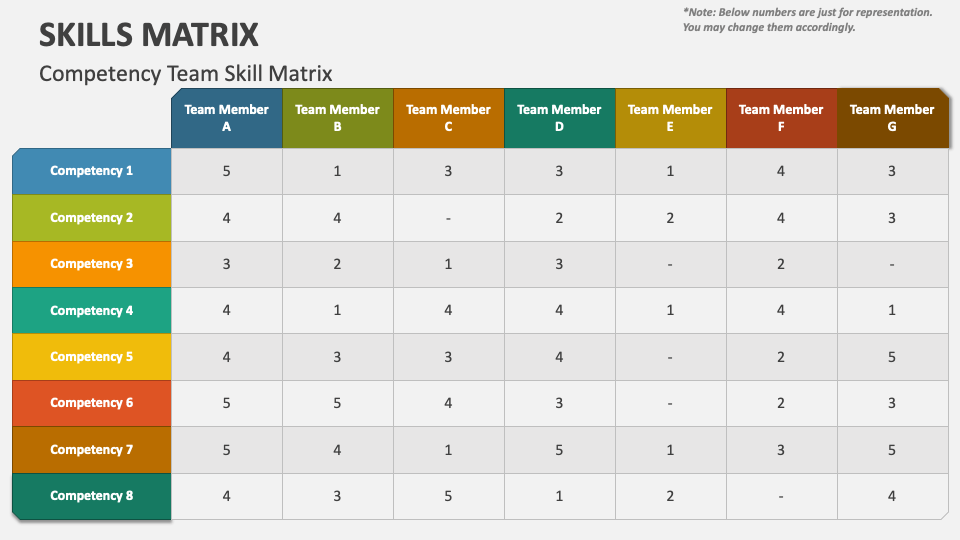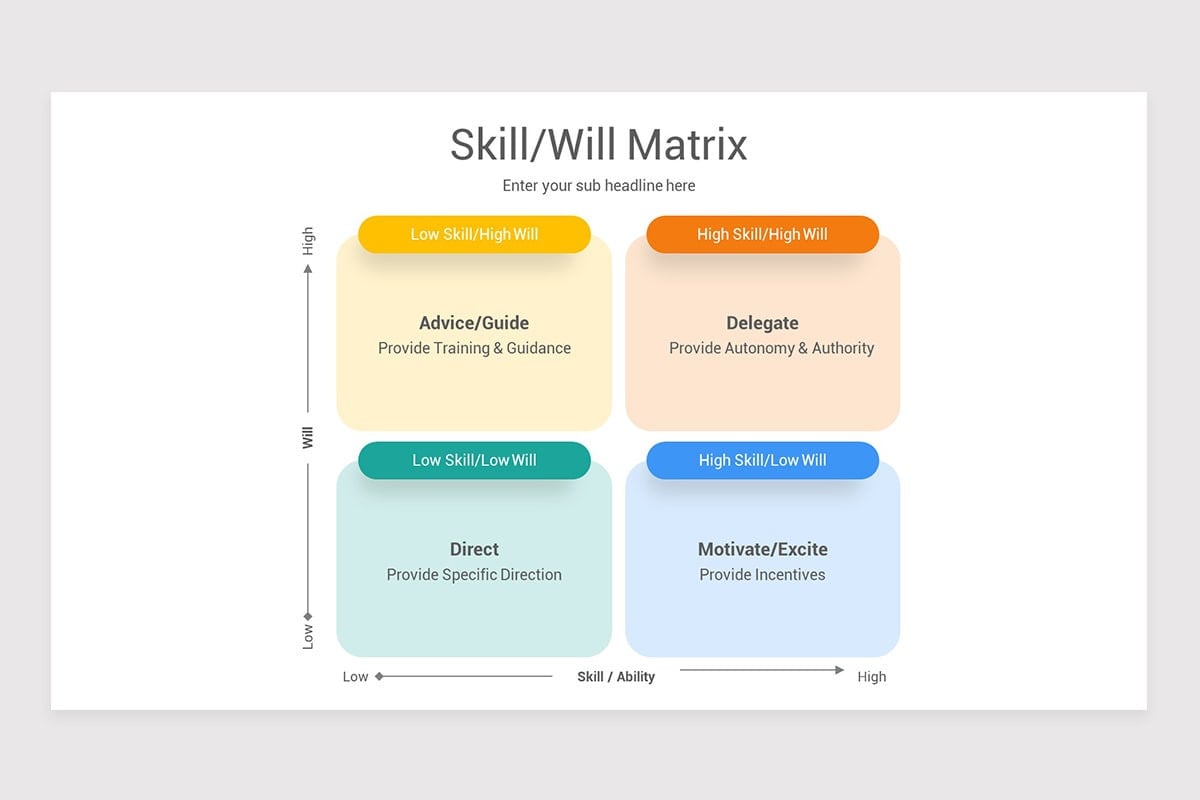Introduction
The Skill Will Matrix emerges as a valuable tool in various critical scenarios where understanding and optimizing team dynamics are paramount. Here are four serious cases where the matrix can be instrumental:
1: Organizational Restructuring
During times of organizational restructuring, roles and responsibilities often undergo significant changes. The Skill Will Matrix becomes indispensable in this context as it aids leaders in assessing the skills and motivations of existing team members. This information guides strategic decisions on realigning roles, delegating tasks, and ensuring a smooth transition.
2: New Team Members
Introducing new members to a team requires a thoughtful approach to integration. The Skill Will Matrix proves essential in this scenario by helping leaders understand the strengths and motivations of each team member. This knowledge allows for more effective onboarding, task assignments, and the establishment of a supportive environment for newcomers.
3: Improving Leadership
Leaders aiming to enhance their effectiveness can leverage the Skill Will Matrix as a self-assessment tool. By evaluating their team’s skills and motivations, leaders can identify areas for improvement in their leadership style. This case underscores the matrix’s value in fostering continuous improvement and adaptability in leadership approaches.
4: Building Agile Teams
In today’s dynamic business environment, agility is a key factor for success. The Skill Will Matrix facilitates the creation of agile teams by providing insights into individual and collective capabilities. This information allows leaders to assemble teams with complementary skills and motivations, fostering adaptability and resilience in the face of changing circumstances.
What is the Skill Will Matrix?
The Skill Will Matrix is a strategic tool designed to assess team members based on their skill levels and motivation. It provides a structured framework for leaders to tailor their approach, taking into account the unique combination of skills and motivation each individual brings to the team.

History of the Skill Will Matrix
While the exact origins may be challenging to pinpoint, the Skill Will Matrix draws inspiration from historical leadership theories. Its development is intertwined with the evolution of management paradigms, particularly the shift towards adaptive and participative leadership styles. Notable management gurus, including Ken Blanchard and Paul Hersey, significantly contributed to the matrix’s evolution.
What is the Difference Between Skill and Will?
In the context of the Skill Will Matrix, skill refers to the technical capabilities and knowledge individuals possess, while will pertain to their motivation and willingness to perform tasks. Recognizing and understanding this distinction is fundamental to effectively utilizing the matrix in assessing and managing team members.
Applications of the Skill Will Matrix:
The Skill Will Matrix finds diverse applications in leadership and team management. It serves as a versatile tool for making strategic decisions, adapting leadership styles, and optimizing team performance based on the specific combination of skills and motivation within the team.
How The Matrix Works:
The functionality of the Skill Will Matrix lies in its ability to categorize team members into four distinct quadrants based on their skill levels and motivation. This categorization guides leaders in tailoring their leadership approaches, ensuring that each team member receives the most effective support and guidance.
Four Quadrants of the Skill Will Matrix:
- Delegate: High Skill, High Motivation
- Guide: High Will, Low Skill
- Excite: High Skill, Low Motivation
- Direct: Low Skill, Low Will
These quadrants offer a comprehensive view of team members’ profiles, allowing leaders to understand where each individual stands in terms of skills and motivation.
Use Cases of the Skill Will Matrix:
Beyond the serious cases mentioned earlier, the Skill Will Matrix finds practical application in various scenarios, including organizational restructuring, integrating new team members, enhancing leadership effectiveness, and building agile teams. Each use case underscores the matrix’s adaptability and relevance in diverse organizational contexts.
When To Use The Skill Will Matrix:
1: Returning To Work
After a hiatus or significant changes, assessing team members’ skills and motivations becomes crucial for a seamless return to work. The Skill Will Matrix guides leaders in understanding how to effectively reintegrate and support team members during this transitional phase.
2: New Team Members
Introducing new members to a team necessitates a clear understanding of their capabilities and motivations. The Skill Will Matrix facilitates a smooth onboarding process by helping leaders tailor their approach to align with the strengths and motivations of new team members.
3: Building An Agile Team
In the pursuit of organizational agility, the Skill Will Matrix aids leaders in assembling teams with diverse yet complementary skills and motivations. This promotes flexibility and adaptability, essential qualities for navigating the ever-changing business landscape.
4: Improving Leadership
Aspiring to enhance leadership effectiveness requires self-reflection and a keen understanding of team dynamics. The Skill Will Matrix serves as a valuable tool for leaders to evaluate their leadership styles and make adjustments based on the skills and motivations of their team members.
Put Performance In Focus:
Ultimately, the Skill Will Matrix places performance at the forefront of leadership and team management. By recognizing and leveraging the unique combination of skills and motivations within a team, leaders can optimize individual and collective performance, contributing to overall organizational success.
Who created the Skill Will Matrix PDF:
The specific creator of the Skill Will Matrix is not attributed to a single individual. Instead, it has evolved through contributions from various management thinkers and leadership theorists. Notable figures like Ken Blanchard and Paul Hersey have significantly influenced its development, making it a collaborative product of the management and leadership community.
Skill Will Matrix Example:
In a Skill Will Matrix example, team members are categorized into four quadrants based on their skill levels and motivation. For instance, an employee with high skills and high motivation would fall into the “Delegate” quadrant, while someone with high will but low skill might be placed in the “Guide” quadrant. This categorization provides a visual representation that guides leaders in tailoring their approach to individual team members.

Skill Will Matrix for Teachers:
For educators, the Skill Will Matrix is a valuable tool to understand and engage with students effectively. Teachers can assess students’ skills and motivation levels, allowing them to tailor their teaching methods. This approach ensures that each student receives the appropriate guidance, whether they need delegation of tasks, guidance, motivation, or direct instruction.
Skill Will Matrix McKinsey:
The Skill Will Matrix is frequently utilized in management consulting, including by renowned firms like McKinsey. It assists consultants in assessing team dynamics, guiding their strategies, and optimizing performance. The matrix’s adaptability aligns with McKinsey’s focus on dynamic problem-solving and effective leadership.
Skill Will Matrix Questionnaire:
A Skill Will Matrix questionnaire is a tool used to gather information about team members’ skills and motivations. By posing targeted questions, leaders can assess individual competencies and willingness, providing valuable data for categorization within the matrix. This questionnaire approach streamlines the process of populating the matrix and ensures a comprehensive understanding of the team.
Skill Will Matrix Coaching:
Coaches often leverage the Skill Will Matrix to enhance their coaching strategies. By categorizing athletes or individuals based on their skills and motivation, coaches can tailor training plans and motivational approaches. This personalized coaching methodology contributes to improved performance and overall team dynamics.
Competency vs. Skill Matrix:
While both competency and skill matrices assess individual capabilities, they differ in focus. A competency matrix evaluates broader attributes such as communication and leadership, whereas a skill matrix specifically measures technical skills. Understanding this difference is crucial for organizations when determining the most relevant assessment tool for their needs.
Skill Matrix for Employees:
A skill matrix for employees outlines the skills and competencies each team member possesses. This comprehensive overview aids in strategic decision-making, task assignment, and training programs. By utilizing a skill matrix, organizations can optimize their workforce, ensuring that each employee’s skills align with the demands of their roles.
Skills Matrix Template Excel Free Download:
An Excel-based skills matrix template offers a user-friendly way to organize and assess team members’ skills. This downloadable tool streamlines the process, allowing organizations to efficiently create and maintain their skill matrices. Excel’s familiar interface enhances accessibility and ease of use.
Who Invented the Skill Will Matrix Essay:
The invention of the Skill Will Matrix is a collaborative effort with no single inventor. It has evolved through contributions from multiple management and leadership thinkers. An essay on the topic would delve into the historical development, key influencers, and the matrix’s practical applications in diverse organizational contexts.
High Skill Will Matrix:
In a High Skill Will Matrix scenario, individuals possess both high skills and high motivation. This quadrant, known as “Delegate,” represents team members who are well-equipped and highly motivated, making them suitable for tasks that require both technical proficiency and initiative.
What is Skill Matrix in the Garment Industry Example:
In the garment industry, a Skill Matrix outlines the technical skills required for various roles. For instance, a sewing operator may need expertise in machine operation, while a quality control inspector should possess skills in defect identification. This example showcases how the matrix aligns skills with specific industry requirements.

What is Skill Matrix in Garment Industry PPT:
A Skill Matrix presentation for the garment industry in PowerPoint format serves as an educational tool. It visually communicates the required skills for different roles within the industry. This presentation format is effective for training sessions and discussions on optimizing workforce capabilities.
Skill Matrix Format in Manufacturing Industry Excel:
In the manufacturing industry, an Excel-based Skill Matrix Format is commonly used to categorize employees based on their skills. This format allows organizations to efficiently manage and update the matrix, ensuring that it reflects the evolving skill sets of the workforce.
Skill Matrix SlideShare:
A Skill Matrix presentation on SlideShare offers a platform for sharing insights and best practices with a broader audience. Professionals can utilize SlideShare to disseminate knowledge about the matrix’s implementation, its benefits, and real-world examples, contributing to industry-wide learning and development.
Competency Matrix Example:
A Competency Matrix Example assesses employees based on broader competencies, such as communication, teamwork, and problem-solving. This matrix complements the Skill Will Matrix by providing a holistic view of individuals’ capabilities beyond technical skills.
Competency Skill Matrix Template:
A template combining both competency and skill matrices offers a comprehensive assessment tool. This dual-focused approach ensures that organizations consider both technical skills and broader competencies when managing and optimizing their workforce.
Competency Matrix PDF:
A Competency Matrix in PDF format provides a convenient and portable resource for organizations. This document outlines the competencies required for various roles, aiding in strategic decision-making and ensuring alignment between individual capabilities and organizational goals.
Skill Matrix Levels:
Skill matrix levels categorize individuals based on their proficiency in specific skills. This hierarchical approach allows organizations to identify skill gaps, implement targeted training programs, and ensure that employees progress through different proficiency levels.
Employee Skill Matrix Chart:
An Employee Skill Matrix Chart visually represents the skills possessed by each team member. This chart is a quick reference tool for leaders, allowing them to identify skill distributions within the team and make informed decisions about task assignments and training initiatives.
Skill Matrix Meaning:
The meaning of a Skill Matrix lies in its ability to categorize individuals based on their skills and motivation. It provides a structured framework for leaders to understand their team’s capabilities and tailor their approach, ultimately optimizing performance and achieving organizational success.





One thought on “4 Serious Cases To Use The Skill Will Matrix”